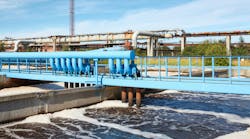Biological wastewater treatment was developed at the beginning of the 20th century and since then, it has become widely accepted as the treatment method for municipal wastewater for the protection of water bodies and to support public health.
Throughout the decades, wastewater treatment facility design standards were developed and published. Commonly referred to as the Ten State Standards, these standards cover a wide range of wastewater treatment issues including flow equalization and activated sludge treatment. They also define the criteria for wastewater aeration (also known as wastewater mixing).
What is air mixing of wastewater?
Air mixing, also known as aeration, is when the air is mixed with the wastewater so that dissolved gases can be removed and dissolved metals such as iron can be oxidized along with the occurrence of microbial degradation of pollutants. In municipal and industrial wastewater, aeration occurs in the secondary treatment process.
Specifically, aeration provides oxygen for the bacteria in the wastewater. Air is pumped into the tank. The bacteria use the oxygen for growth and also for the biodegradation of organic matter to produce carbon dioxide and water.
Benefits of aeration to the wastewater
Aeration provides dissolved oxygen to the wastewater. The dissolved oxygen supports microbial growth in the wastewater and the microbes in turn, biodegrade the organic matter present in the wastewater.
Biodegradation of organic matter in the absence of dissolved oxygen is a very slow process and it is also odorous due to the formation of hydrogen sulfide and methane. In the absence of dissolved oxygen, organic acids can also be formed and these acids create a low pH that makes the wastewater difficult to treat.
What is the function of a mixing chamber for wastewater treatment?
The mixing chamber in a wastewater treatment process, as the name implies, mixes the components in the tank. There is a concept known as flash mixing in water treatment. After debris is screened out, chemicals that enhances coagulation are added to the water and the mixture is quickly agitated in a process known as flash mixing. This mixing allows the chemicals to attract fine particles such as silt and make them clump together. In the clump-like state, they are heavier and referred to as floc. The floc is easier to remove from the water than the silt.
The directional flow in the mixing chamber is important because it determines the dispersion of chemicals in the water and thus, affects floc formation. The directional flow could be a vertical flow or a horizontal flow and both of these approaches require vigorous mixing. A flow pattern at the right angle is required to rapidly blend the chemicals uniformly for floc removal.
Mixing is advantageous for evenly distributing chemicals and for reducing the amount of treatment agents required for the sedimentation process. Mixing ensures faster and thorough reactions between the chemicals and the silt for floc formation.
Floc removal, done via mixing as described above, is important because too much silt in the water can interfere with the microbial degradation process. The silt can interfere with the formation of biofilm and with the degradation of pollutants including organic pollutants in the water. It can also interfere with oxygen delivery, via the mixing process, to the microorganisms that degrade the pollutants.
Which chemical is most commonly used in wastewater treatment?
Oxygen itself could also be added to the wastewater. Although oxygen is added via mixing, there are instances when pure oxygen can be added. This is done when the wastewater treatment facility does not have sufficient airflow at the secondary or biological treatment facility and/or other related issues.
In this case, the oxygen is added to the wastewater via an oxygen system which consists of an oxygen storage and supply tank. This stores cryogenic oxygen. The oxygen is vaporized, flows to the valve, and is injected via spargers, diffusers, hoses, or a device.
There are several chemicals that are used in wastewater treatment and these include lime, ferrous sulfate, alum (aluminum sulfate), ferric chloride, and also polymers such as anionic, cationic, or nonionic high molecular weight compounds.
Ferrous sulfate
Ferrous sulfate, while typically used with lime to soften water, also forms calcium sulfate and ferric hydroxide in the presence of dissolved oxygen. This shows another use of mixing to aerate the wastewater, i.e., in addition to providing oxygen for the microbial degradation of organic chemicals, the dissolved oxygen is also useful for softening water.
Hydrogen peroxide
There are other chemicals that are also useful for the aeration of wastewater such as hydrogen peroxide. In an activated sludge system containing hydrogen peroxide, the microorganisms via enzymatic reaction, convert the hydrogen peroxide to water and oxygen. The amount of hydrogen peroxide to add depends on several wastewater treatment parameters including the pH and the concentration of the total suspended solids.
Paracetic acid
Peracetic acid is another chemical for wastewater treatment. Besides its use as a disinfecting agent, it also keeps the biological oxygen demand in the water at a healthy level. Peracetic acid is itself a food source for some types of bacteria and thus, it increases the population of these bacteria and in the long run, the healthy population of these bacteria keep the biological oxygen demand in check to allow continuous biodegradation of pollutants in the wastewater.
What methods of aeration exists for wastewater treatment?
There are two types of aeration used in wastewater treatment, subsurface aeration and surface aeration.
In the subsurface aeration system, a primary system for aeration of wastewater, oxygen is delivered to the microorganisms in the wastewater by injecting air into the wastewater. The air is first compressed via air pumps or blowers before it travels to the diffusers located along the bottom of the lagoon or the wastewater treatment tank. Some of the methods for subsurface aeration of wastewater are diffused aeration and compressed gas mixing.
Diffused aeration
In a typical diffused aeration process, air is delivered to the microorganisms in the sludge by aeration blowers resulting in small bubbles. The small bubbles, in addition to mixing the content of the tank including mixing the suspended solids, also deliver oxygen to the microorganisms.
Compressed gas mixing
In compressed gas mixing, short duration bursts of compressed air through nozzles located near the tank floor are delivered into the tank. The mixing parameters (pressure, duration, and frequency) may be adjusted to provide mixing in the tank. The compressed gas mixing system has been used at the North Regional Water Reclamation Facility in Palmetto, Florida and at the Broomfield Wastewater Reclamation Facility in Broomfield, Colorado.
Surface aeration is commonly used in pond and lagoon treatment systems. Equipment for surface aeration include spray nozzles and jet fountains that can be fixed or positioned on a pontoon. When the water is sprayed via these equipment, air mixes with the water and the mixing of the air bubbles occur in the wastewater, allowing a high oxygen transfer rate to the wastewater. However, only the area directly surrounding the aerator benefits from this oxygen delivery.
Issues associated with aeration
If the wastewater treatment parameters in regard to the activated sludge are not managed sufficiently, oxygen supersaturation can occur. While aeration typically raises the concentration of dissolved oxygen in the water, too much oxygen in the water can supersaturate the water with oxygen leading to corrosion (the gradual decomposition of metal surfaces) and sedimentation problems. Additionally, oxygen supersaturation of the water can promote algae growth which in turn can clog filters.
Mixing provides aeration, which in turn helps to biodegrade pollutants — including organic matter present in the wastewater — through the actions of microorganisms. There are several ways to mix the wastewater as described in this article.
Although aeration, just like any other aspect of wastewater treatment, has advantages and also challenges, aeration is one of the methods to achieve permit limits such as for the NPDES permits.







